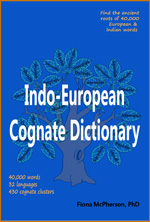Vocabulary is a sticking point for many language learners. That’s because words have a certain arbitrary quality that makes them hard to memorize. There are two strategies which are very effective with this task: the keyword mnemonic, and retrieval practice. I have written about these extensively in my books Mnemonics for Study, and How to revise & practice. But you need thousands of words to have any degree of fluency, and you’ll be much quicker to reach that level if you don’t have to apply these strategies to all words. Which is where we come to the relative ease of learning different languages. One of the main factors determining the ease or difficulty of mastering another language is the degree to which it shares vocabulary with the language(s) you know.
If you’ve done any study of a language related to your own, you’ll know about cognates. They’re the words that are easiest to learn because they’re similar to the words you already know, because they’re descended from the same root word. So, for example, ‘important’ is cognate with:
- French important
- Spanish importante
- Portuguese importante
- Italian importante
- Romanian important
That’s a very obvious set! The reason is that these are all Romance languages — they descend from Latin. In this case, from Latin importans. Clearly, if you were learning the word in any of these languages, you wouldn’t even bother ‘learning’ it.
While English has much in common with the Romance languages, because of its extensive borrowing from French after the Norman Invasion (and also because of the strong influence of Latin, being the language of the Church and scholars for so many centuries), it is at heart a Germanic language. Let’s have a look at the Germanic words for this term:
- German wichtig
- Frisian wichtich
- Norwegian viktig
- Swedish viktig
- Danish vigtig
- Icelandic mikilvægt
This last one is less clearly part of the set, but you can see the relationship if you separate it into mikil-vægt.
All this appears completely unrelated to English, but in fact there is a relationship. Another word for important is weighty, and indeed, ‘weight’ and ‘weighty’ are cognate with these Germanic words, as is Dutch wichtig (meaning bulky), and German Gewicht (weight).
If you were learning German, and simply tried to memorize ‘wichtig = important’, there’s nothing to hook onto for your memory. However, if instead you were to think of it as ‘wichtig = weighty, important’, the new word becomes much easier to remember.
(A side-note for those interested in this sort of thing: the Germanic set are descended from the Proto-Indo-European word *weǵh-, while the Romance set are descended from *per-; intriguingly, both words have similar meanings of to bring, to transport, to carry forth.)
Let’s have a look at a fuller cognate cluster (this is a truncated set of the one appearing in the Indo-European Cognate Dictionary; for a full example of a cognate cluster, see my blog post). This is the cluster descending from the Proto-Indo-European word for hundred:
*ḱm̥tóm
hundred
Germanic: hundred (Eng); hundred (OE); hûndert (Fris); honderd (Dut); Hundert (Ger); hundrað (Norse); hundre (Nor); hundra (Swe); hundrede (Dan); hundrað (Ice)
Celtic: cant (Wel); céad (Iri)
Italic: centum, centuria, centēnārius (Lat);
cent, centurie, centenaire (Fr);
cento, centuria (Ital);
cien, ciento, centuria, centenario (Sp);
cem, cento, centúria (Port);
cent, centurie (Rom)
Derivatives: cent, centimeter/centimetre, century, centennial, centenary, percentage (Eng);
centi-, centimeter (Dut); Zenturie, Zentner (Ger); centimeter (Nor); centimeter (Swe); centi-, centimeter (Dan);
κεντηνάριον (kentēnárion) (AnGk); центу́рия (centúrija) (Rus); qind, njëqind (Alb)
Hellenic: ἑκατόν (hekatón) (AnGk); εκατό (ekató) (Gk)
Derivatives: hecato- (Eng)
Slavic: сто (sto) (Rus); sto (Pol); sto (Cz); sto (Slo); сто (sto) (Mace)
Baltic: šim̃tas (Lith); simts (Latv)
Indo-Iranian: शत (śatá), शतम् (śatam) (Sans); सौ (sau) (Hin); سل (səl) (Pash); صد (sad) (Pers)
It is not in any way obvious that hundred and cent are related (except in meaning), but two patterns make the relationship clearer.
First of all, there’s a fundamental distinction between the ‘Western’ and ‘Eastern’ branches of the Indo-European tree, that’s expressed as the kentum-satem divide. This reflects the fact that most of the Western languages have a word for hundred that begins with a hard k sound, like Latin centum, while in the Eastern languages, the word for hundred begins with a soft s sound, as in the Sanskrit word satem. This distinction between a hard k and a soft s sound is thought to reflect a very early split in the Proto-Indo-European tribes, as some headed west and others east. Note how that Western-Eastern divide plays out in the branches:
Western (kentum): Celtic, Germanic, Italic, Greek, Anatolian
Eastern (satem): Balto-Slavic, Armenian, Albanian, Indo-Iranian
The second pattern is that in the Germanic languages, as Grimm’s laws describe, k becomes h, and t becomes d. So, *ḱm̥tóm becomes (eventually) hundred.
These patterns are why English has hundred, while words relating to hundred are based on cent (from Latin) or (more academically) hecato (from Ancient Greek).
This cluster can be used by anyone learning a language represented in the cluster, if they already know another of the languages in the cluster. For more examples of cognates specific to English and another language in the Indo-European family, see these:
Using cognates to learn Italian vocabulary
(more to follow)
